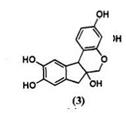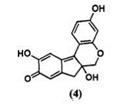 |
 |
The most valuable colorless naturally occurring hydroquinone is hematoxylin (1)3 which is extracted from logwood, native to Central America. Compound 1 absorbs at 298nm in methanol but is rapidly oxidized by atmospheric oxygen and converts to hematein (2) which contains a para — quinoidal chromophore. Compound 1 is white in the pure state, turning yellow in air before undergoing further oxidation to a dark-colored material. The color of naturally occurring hematoxylin is due to the presence of hematein as an impurity. Compound 2 forms chelates with various metals giving a range of colors from reddish-violet, blue to black depending on the metal (C. I. Natural Black 1 and 2). Compound 1 is an excellent nuclear stain; several thousand pounds of this dye are used worldwide each year in biological-stain applications. A similar hydroquinone is brazilin (3) which is also oxidized to brazilein (4) (C. I. Natural Red 24). Naturally occurring quinones have been summarized by Venkataraman.4
 6 июля, 2015
6 июля, 2015  Malyar
Malyar  Опубликовано в рубрике
Опубликовано в рубрике 